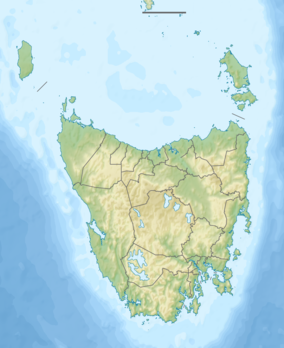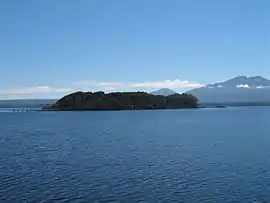Macquarie Harbour
Macquarie Harbour is a large, shallow, inlet, located in the West Coast region of Tasmania, Australia. It is approximately 315 sq.km, and has an average depth of 15m, with deeper places up to 50m. The inlet is navigable by shallow-draft vessels. The main channel is kept clear by the presence of a rock wall on the outside of the channel's curve. This man-made wall prevents erosion and keeps the channel deep and narrow, rather than allowing the channel to become wide and shallow. A reported Aboriginal name for the harbour is Parralaongatek.[1]
| Macquarie Harbour | |
|---|---|
 A view across Macquarie Harbour (Mount Sorell at rear). | |
 Macquarie Harbour Location in Tasmania | |
 False colour Landsat image centred on Macquarie Harbour, looking northwest, draped over digital elevation model with x2 vertical exaggeration; screen capture from the NASA World Wind | |
| Location | Western Tasmania |
| Coordinates | 42°17′38″S 145°21′31″E |
| Native name | Parralaongatek |
| Etymology | Lachlan Macquarie, the 5th Colonial Governor of New South Wales |
| River sources | |
| Ocean/sea sources | Southern Ocean |
| Basin countries | Australia |
| Islands | Sarah Island |
| Sections/sub-basins | |
| Settlements | Strahan |
The harbour was named in honour of Scottish Major General Lachlan Macquarie, the fifth Colonial Governor of New South Wales.
History
James Kelly wrote in his narrative First Discovery of Port Davey and Macquarie Harbour how he sailed from Hobart in a small open five-oared whaleboat to discover Macquarie Harbour on 28 December 1815.[2]
However, different accounts of the journey have indicated different methods and dates of the discovery. In the commentary to the Historical Records of Australia, the editor notes that T.W. Birch stated before the commission of inquiry into the state of the colony in 1820 that Kelly had discovered Macquarie Harbour after proceeding along in a boat from Port Davey where they had travelled in the schooner Henrietta Packet. Kelly gave evidence before the commission, and did not mention any discoveries. In a letter dated 11 April 1816, preserved in the record office, London, T.W. Birch transmitted an account of this voyage, which records the discovery of Macquarie Harbour on 26 December 1815.[3]
Charles Whitham notes variations on the date.[4]
Surveyor-General Oxley of New South Wales in March 1820 battled with the seas around the heads and Hells Gates. Surveyor-General Evans travelled in the area in 1821-22.
In September 2020, almost 100 Pilot whales were rescued from the harbour after becoming stranded. An estimated 350 whales which were unable to be rescued died.[5]
Convict era
The harbour was established as a prison which was a place of "extreme physical and mental torture" .[6] It was built for British convicts but many Irish patriots and Tasmanian Aborigines were also detained there.
Rivers
The King River which cuts through the West Coast Range and the Gordon River empty into Macquarie Harbour. The narrow entrance to Macquarie Harbour has hazardous tidal currents and is called Hell's Gates. Outside of the Harbour the entrance area is known as Macquarie Heads, and the most western point is Cape Sorell. The sheer volume of fresh water that pours into the Harbour through the rivers, combined with the narrow exit result in barometric tides. When there is rain in the mountains surrounding the Harbour, the tide rises, and it falls when the atmospheric pressure reverses and results in less rain.
The Queen River, King River and Macquarie Harbour were all polluted by mine waste from the Mount Lyell Mining and Railway Company until its closing in 1994. It is estimated that 100 million tonnes of tailings were disposed of into the Queen River. The Mount Lyell Remediation and Research and Demonstration Program was carried out by the office of Supervising Scientist and the Tasmanian Department of Environment and Land Management over the following two years. The result of the program a marked reduction in the waste material entering the rivers and harbour.
- Bird River - mouth of river in Kelly Basin
- Braddon River - mouth on mid-eastern shore
- Clark River - mouth at Pillinger, Kelly Basin.
- Gordon River - mouth on south eastern end of harbour
- King River - mouth at north east of harbour
Islands


The Islands are regularly surveyed.[7]
- Bonnet Island - in Kelly Channel at entrance to harbour (42° 13′ S, 145° 14′ E)[8]
- Cat Island
- Elizabeth Island
- Entrance Island - at entrance to harbour (42° 12′ S, 145° 14′ E)
- Magazine Island
- Neck Island
- Philips Island - adjacent to mouth of Braddon River on east shore
- Sarah Island - in southern part of Harbour
- Soldiers Island
Settlements
The first settlement at Macquarie Harbour was on Sarah Island, a small island in the harbour, named after the wife of Thomas William Birch. This island was used as a prison for recalcitrant prisoners from other settlements in Tasmania, due to its extreme isolation and extreme climate.
Later the small port of Strahan was developed on the shores of Macquarie Harbour to support the nearby mining settlements, mainly Queenstown. Another port was developed on the south east section of the harbour in Kelly Basin along with townsite of Pillinger. The settlement and port were short lived as was the North Mount Lyell company that developed the facilities.
Named features

- Birchs Inlet - at south west end of harbour
- Farm Cove - at south east side
- Gould Point - adjacent to Farm Cove
- Hell's Gates - mouth at north west end of harbour
- Kelly Basin - port/town at southern end of harbour - see also Pillinger
- Kelly Channel - at entrance to harbour
- Lettes Bay - between Regatta Point and King River mouth
- Liberty Point - on mid western shore
- Long Bay - south of Regatta Point
- Pillinger - name of abandoned townsite in Kelly Basin
- Pine Cove - just south of the King River Mouth
- Regatta Point - eastern side of Risby Cove
- Risby Cove - water between Strahan Harbour and Regatta Point
- Rum Point - on western shore south of Sarah Island
- Sophia Point - on mid-eastern shore
- Strahan Harbour - from Strahan Point parallel to 'The Esplanade'
- Swan Basin - near Hell's Gates
Tourism
Today Strahan is the base for tourism on the west coast. The West Coast Wilderness Railway takes part of the north eastern shore of the Harbour, before turning inland at the mouth of the King River.
Boats take tourists to Hell's Gates and Macquarie Heads, Sarah Island and up the lower reaches of the Gordon River. Also charter flights utilise Strahan Airport for helicopter and fixed wing flights.
Salmon farms
Salmon farming, and a range of associated environmental issues in Macquarie Harbour, have been present for some years.[9][10][11][12][13]
Current management practices have been questioned and challenged[14][15]
Also the fate of the endangered Maugean skate has been examined in relation to current practices[16]
See also
| Wikimedia Commons has media related to Macquarie Harbour. |
References
- Milligan, Joseph (1858). "On the dialects and languages of the Aboriginal Tribes of Tasmania, and on their manners and customs" (PDF). Papers of the Royal Society of Tasmania: 270.
- Kelly, James, Some unrecorded passages in the history of Van Diemen's Land (from a Very Old Stager) (PDF)
- Historical Records of Australia, III, 2, p. 778, archived from the original on 14 March 2011
- Whitham, Charles (1924). Western Tasmania: a land of riches and beauty. Queenstown, Tasmania: Mount Lyell Tourist Association. p. 168. ASIN B0008BM4XC. OCLC 35070001.
- "Almost 100 pilot whales rescued after mass stranding on Tasmania's West Coast". abc.net.au.
- Flannery, T.F. (1994) The Future Eaters: An ecological history of the Australasian lands and people Chatswood: New South Wales ISBN 0-8021-3943-4
- Pemberton, Michael; Hawkins, Clare; Hamish Saunders Memorial Trust (New Zealand); Tasmania. Department of Primary Industries, Parks, Water and Environment (2011), The islands of Macquarie Harbour : Hamish Saunders Memorial Island Survey Program 2009, Department of Primary Industries, Parks, Water and Environment, ISBN 978-0-7246-6567-9CS1 maint: multiple names: authors list (link)
- Brothers, Nigel; Pemberton, David; Pryor, Helen; & Halley, Vanessa. (2001). Tasmania’s Offshore Islands: seabirds and other natural features. Tasmanian Museum and Art Gallery: Hobart. ISBN 0-7246-4816-X
- http://www.et.org.au/salmon_faqs
- http://www.abc.net.au/news/2016-03-01/tassal-declares-macquarie-harbour-salmon-farming-sustainable/7210338
- http://www.abc.net.au/news/2016-04-14/council-secures-right-to-charge-seabed-rates-in-high-court/7325730
- http://www.abc.net.au/news/2016-04-29/environmentalists-ready-to-fight-increase-in-salmon-farming/7368882
- http://www.abc.net.au/news/2016-10-31/salmon-farmer-says-tas-government-ignored-overstocking-warning/7978770
- http://www.abc.net.au/news/2017-02-06/huon-aquaculture-lawsuit-tasmania-government-macquarie-harbour/8244330
- http://www.abc.net.au/news/2017-02-07/tas-govt-huon-aquaculture-lawsuit-over-macquarie-harbour/8247072
- Bell, Justin; Lyle, Jeremy, (author.); Semmens, Jayson, (author.); Awruch, Cynthia, (author.); Moreno, David, (author.); Currie, Suzie, (author.); Morash, Andrea, (author.); Ross, D. J. (Donald Jeff), (author.); Barrett, Neville, (author.); Institute for Marine and Antarctic Studies (Tas.); Fisheries Research and Development Corporation (Australia) (2016), Movement, habitat utilisation and population status of the endangered Maugean skate and implications for fishing and aquaculture operations in Macquarie Harbour, Deakin, ACT Fisheries Research and Development Corporation (FRDC), ISBN 978-1-86295-851-7CS1 maint: multiple names: authors list (link)
Further reading
- Lempriere, T. G. (1842). "Account of Macquarie Harbour". Tasmanian Journal of Natural Science (manuscript). 1: 39–49.
- Blainey, Geoffrey (2000). The Peaks of Lyell (6th ed.). Hobart: St. David's Park Publishing. ISBN 0-7246-2265-9.
- Kelly, James, 1791-1859. First discovery of Port Davey and Macquarie Harbour p 160-181 "Royal Society of Tasmania: Papers and Proceedings, 1920. Issued separately 24th December, 1920" Microfiche. Canberra : National Library of Australia, 2004.